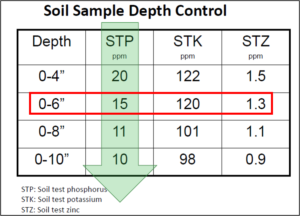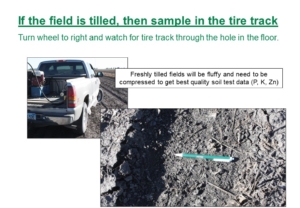Soil Sample Before Tillage: Consistent sample depth matters!
The fall harvest season is a busy time of year. Farmers need to finish harvest, apply fertilizer, and complete any tillage operations before the long winter sets in. Another field operation that needs to be completed within this flurry of activity is soil sampling, and sampling timing is crucial to getting quality and consistent soil cores.
Do your best to soil sample fields before any tillage pass. Tillage makes collecting soil cores with consistent depths very difficult, which can affect test results. Soil test results are only as reliable as the soil samples that were collected from the field. If a sample is submitted as a 0 to 6-inch sample and is only really the top 0 to 4-inch of the soil, soil test values are inflated compared to actual 0 to 6-inch results. The opposite happens if a core is actually deeper than the 0 to 6-inch depth: soil test values are diluted if the sample that was submitted is deeper. The table below shows an example of how test levels of non-mobile nutrients like P, K, and Zn decrease as soil core length increases.
Why tillage affects sampling depth consistency and core quality
Tillage breaks apart soil and introduces air, essentially “fluffing” the soil. Sampling after the soil has been “fluffed” means the sampler has to guess what actually represents a 6-inch soil depth for that field. What was a 0 to 6-inch core in the soil probe before tillage might actually take up 8 inches in the soil probe now, given the soil profile is now “fluffy” after tillage. Over time the soil will settle, but when does that happen? How fast does that happen? When will 0 to 6 inches of tilled soil in the soil probe actually represent a 0 to 6-inch depth again? No one can accurately answer these questions.
Beyond the soil being “fluffy” after tillage, tillage loosens soil aggregates, makes clods, and generally dries the soil. This means loose soil may fall out of the probe or the probe pushes around the clods at the surface and does not get a true 0 to 6-inch sample. This might mean a core that’s collected and sent to the laboratory might actually be a 2 to 8-inch depth core, or a 2 to 6-inch depth core.
A tip for sampling after tillage
If you have to sample after tillage, sample in the wheel track. The tire compresses the soil and allows you to get a better opportunity at a true 0 to 6-soil core depth.
Getting consistent soil core depths is crucial. Sampling before tillage is the best thing you can do to ensure quality cores with consistent depths. Sampling after tillage can result in lower test levels for non-mobile nutrients like P, K, and Zn. Please call either AGVISE laboratory and ask for one of our technical support staff if you have any questions about sampling after a field has been tilled.


